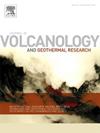Volcanic tremor associated with successive gas emission activity at a boiling pool: Analyses of seismic array and visible image data recorded at Iwo-Yama in Kirishima Volcanic complex, Japan
IF 2.4
3区 地球科学
Q2 GEOSCIENCES, MULTIDISCIPLINARY
Journal of Volcanology and Geothermal Research
Pub Date : 2024-11-01
DOI:10.1016/j.jvolgeores.2024.108212
引用次数: 0
Abstract
Volcanic tremors are often observed during volcanic activity and volcanic eruptions, and their generation processes provide clues for understanding volcanic fluid activity underground and eruption dynamics. However, tremors are characterized by continuous oscillations that mask P- and S-waves; hence few studies have precisely located the source, which is the most fundamental information for understanding the generation mechanism. In this study, we focus on volcanic tremors excited by continuous gas emissions occurring at a vent called Y2a in Iwo-Yama, the Kirishima Volcanic Complex, Japan, to clarify the source process of the tremor as well as gas emission activity. We simultaneously observed the volcanic tremor by deploying a small aperture array consisting of six seismometers and the gas emission activity by using a newly developed visual IoT system that can be operated without commercial electricity. MUSIC analysis locates the tremor at depths ranging from the ground surface to approximately 200 m beneath the Y2a and Y2b vents, which are approximately 30 m apart, for approximately four months from November 2021 to February 2022. The source locations of the tremors in the 2 Hz (1.2–2.6 Hz), 4 Hz (3–4 Hz), and 5 Hz (4–5.5 Hz) ranges show some differences and changes with time. The source location tends to become deeper when the 2 Hz amplitude is large. The infrasound generated by gas emission activity is dominant in the tremor signals, which are recognized in the wave propagation velocity with an acoustic velocity of 330 m/s when the 2 Hz amplitude is small. The visual IoT system succeeded in detecting long-term changes in the gas emission activity, and we found that the 2 Hz amplitude of tremor was well correlated with the amount of hot water in the boiling pool of Y2a, which was controlled by precipitation and evaporation during non-rainy days. From these observations, we infer that the volcanic tremor is generated by resonance of volcanic gas and hot water in a crack-like structure beneath Y2a. The resonance was triggered by the counterforces of the gas emissions in the boiling pool, and the infrasound was dominant during periods of hot water depletion in the boiling pool. Temporal changes in the source depths may be caused by changes in the fluid properties, configuration of the resonator and/or the strengths of the underground sources and infrasound. Our simultaneous observations of seismic array and visual IoT system clarify that even the continuous gas emission activity that looks stable is controlled by external sources such as precipitation.
与沸腾池连续气体排放活动有关的火山震颤:日本雾岛火山群岩尾山记录的地震阵列和可见光图像数据分析
在火山活动和火山喷发期间经常会观测到火山震颤,其产生过程为了解地下火山流体活动和火山喷发动力学提供了线索。然而,震颤的特点是连续振荡,掩盖了 P 波和 S 波,因此很少有研究能精确定位震源,而震源是了解震颤产生机制的最基本信息。在本研究中,我们重点研究了发生在日本雾岛火山群岩尾山 Y2a 喷口的连续气体排放所激发的火山震颤,以明确震颤源过程以及气体排放活动。我们通过部署由六个地震仪组成的小孔径阵列同时观测了火山震颤,并利用新开发的无需商业电力即可运行的可视物联网系统观测了气体排放活动。MUSIC 分析确定了 2021 年 11 月至 2022 年 2 月约四个月期间从地表到相距约 30 米的 Y2a 和 Y2b 喷口下方约 200 米深处的震源位置。2 Hz(1.2-2.6 Hz)、4 Hz(3-4 Hz)和 5 Hz(4-5.5 Hz)范围内的震源位置随着时间的推移出现了一些差异和变化。当 2 赫兹振幅较大时,声源位置会变得更深。气体排放活动产生的次声在震颤信号中占主导地位,当 2 Hz 振幅较小时,可从声速为 330 m/s 的波传播速度中识别出来。视觉物联网系统成功地探测到了气体发射活动的长期变化,我们发现震颤的 2 赫兹振幅与 Y2a 号沸腾池中的热水量密切相关,而热水量在非雨天受降水和蒸发的控制。根据这些观察结果,我们推断火山震颤是由火山气体和热水在 Y2a 地下的裂缝状结构中共振产生的。沸腾池中气体排放的反作用力引发了共振,在沸腾池中热水耗尽期间,次声占主导地位。震源深度的时间变化可能是由流体性质、共振器构造和/或地下震源和次声强度的变化引起的。我们对地震阵列和可视物联网系统的同步观测表明,即使是看似稳定的连续气体排放活动也受到降水等外部来源的控制。
本文章由计算机程序翻译,如有差异,请以英文原文为准。
求助全文
约1分钟内获得全文
求助全文
来源期刊
CiteScore
5.90
自引率
13.80%
发文量
183
审稿时长
19.7 weeks
期刊介绍:
An international research journal with focus on volcanic and geothermal processes and their impact on the environment and society.
Submission of papers covering the following aspects of volcanology and geothermal research are encouraged:
(1) Geological aspects of volcanic systems: volcano stratigraphy, structure and tectonic influence; eruptive history; evolution of volcanic landforms; eruption style and progress; dispersal patterns of lava and ash; analysis of real-time eruption observations.
(2) Geochemical and petrological aspects of volcanic rocks: magma genesis and evolution; crystallization; volatile compositions, solubility, and degassing; volcanic petrography and textural analysis.
(3) Hydrology, geochemistry and measurement of volcanic and hydrothermal fluids: volcanic gas emissions; fumaroles and springs; crater lakes; hydrothermal mineralization.
(4) Geophysical aspects of volcanic systems: physical properties of volcanic rocks and magmas; heat flow studies; volcano seismology, geodesy and remote sensing.
(5) Computational modeling and experimental simulation of magmatic and hydrothermal processes: eruption dynamics; magma transport and storage; plume dynamics and ash dispersal; lava flow dynamics; hydrothermal fluid flow; thermodynamics of aqueous fluids and melts.
(6) Volcano hazard and risk research: hazard zonation methodology, development of forecasting tools; assessment techniques for vulnerability and impact.

 求助内容:
求助内容: 应助结果提醒方式:
应助结果提醒方式:


